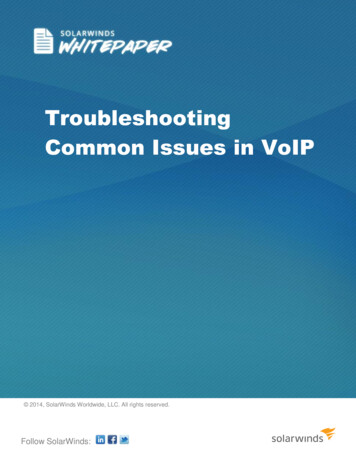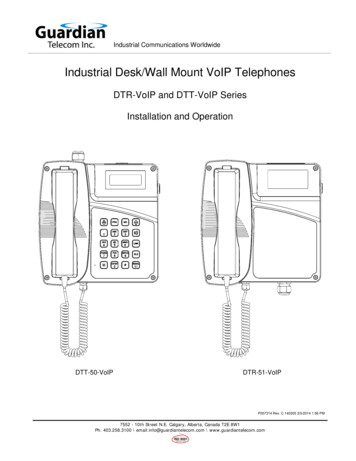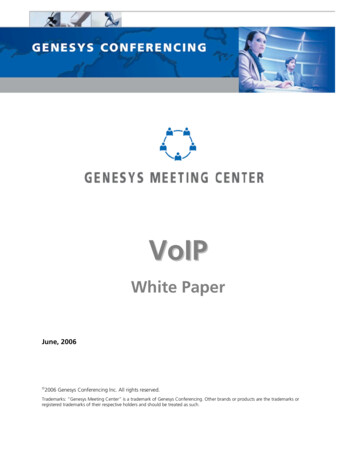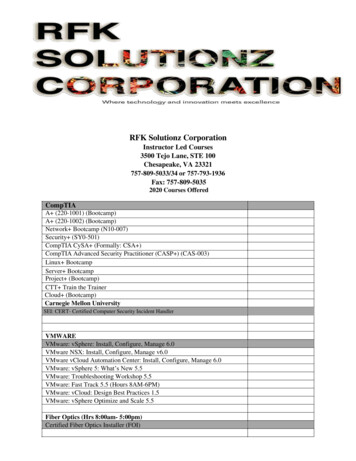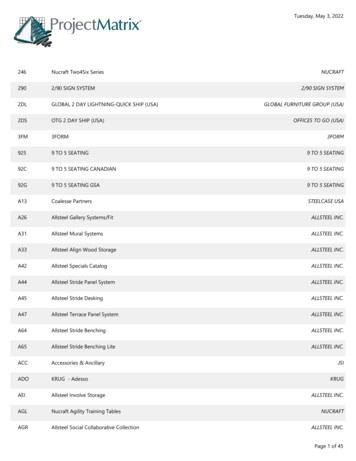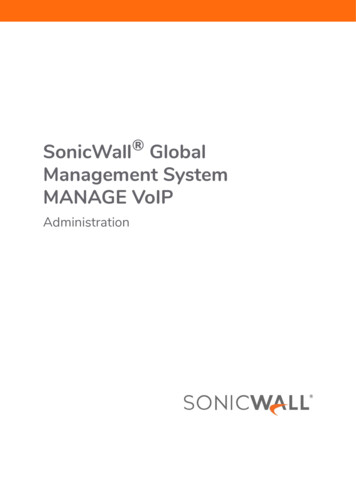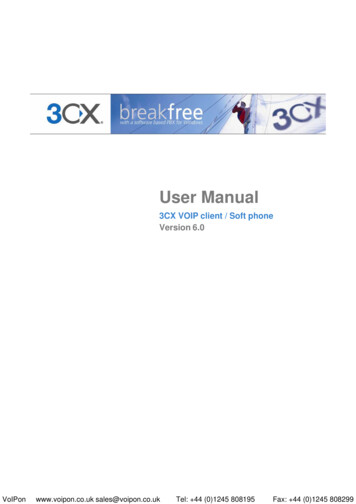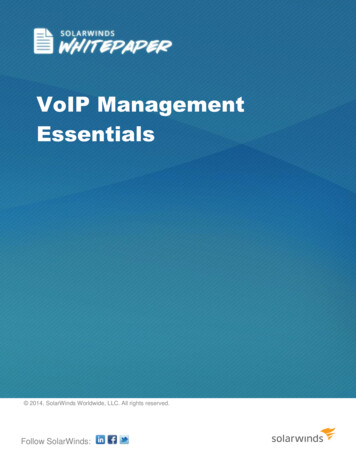
Transcription
VoIP ManagementEssentials 2014, SolarWinds Worldwide, LLC. All rights reserved.Follow SolarWinds:
Executive OverviewThe rapid change from legacy packed switched voice services to Voice over IP (VoIP) has created newchallenges in understanding and managing today’s voice networks. Voice support had migrated away from adedicated Voice Support Group and now rests entirely on the Network Support Group. As with any newtechnology, the transition to VoIP brings new challenges and expectations. Legacy voice systems were built tosupport a 99.999% (five nines) uptime service levels, and they did well supporting that expectation. The legacypath to five nines support was typically closed with proprietary systems that, by their nature, are only managedwith vendor tools. Equipment vendors publish tools as a cost center. Their money is made by sellingequipment, not tools. Tools are a distraction from the main business and receive little development focus.With the move to VoIP, VoIP tools moved from voice switching vendors to network vendors. Two paths forVoIP management emerged: appliance based VoIP monitoring and software solutions. Appliance basedsystems offer some insight into specific calls and statics about individual calls at the cost of a lack of focus onoverall call capabilities. Also, appliance solutions lack the ability to predict VoIP capabilities before a problemoccurs. In contrast, software solutions such as SolarWinds Voice and Network Quality Manager (VNQM) offerthe ability to track call-by-call quality, as well as predict the ability of VoIP systems to handle calls before anissue arises. SolarWinds VNQM tests VoIP quality from multiple sites, 24 hours a day, 7 days a week. It canalso test several essential network services such as DNS, HTTP, and FTP. As a non-appliance solution,SolarWinds VNQM offers superior management at a fraction of the cost of appliance-based solutions. Inaddition, VNQM fully integrates with SolarWinds Network Performance Monitor (NPM).VoIP OverviewVoIP has been a rapidly emerging technology over the past fifteen years. In the early 1990s VoIP was littlemore than a promise of high quality inexpensive voice technology. Over the next ten or so years a battle wasfought over the best way to convince network managers to convert legacy analog voice services to VoIP. Oneissue that stood in the way of VoIP was acceptance. This was partially due to the ability of equipment vendorsto prove and deliver ROI for a new technology. During that time, legacy voice prices were in a free fall and thatcast doubt on the ROI of VoIP services. One goal of IT technology is to provide better service at a lower cost,so solid ROI data is always necessary.Once early adopters made the change to VoIP, the VoIP vendors were able to deliver compelling ROI data andmany legacy long haul carriers announced they would no longer offer or support traditional long-haul voiceservices. From then on, VoIP had little to no resistance in becoming the de facto voice technology. Now voiceFollow SolarWinds:2
and networks use the same wires, switches, and MPLS routers. They even act as a power supply to phones,using power-over-Ethernet (POE).The Final Goal – Ubiquitous VoIP ServicesToday the conversion to VoIP is almost complete and you’d have trouble finding a business that still relies onlegacy voice services. What used to be an entire cost center completely focused on supporting voice is gone.Expectations for voice quality and reliability have not changed since the VoIP conversion. The bar has beenraised for expectations of network services. MPLS (Multiprotocol Label Switching) is now the WAN technologyof choice and all resistance to converting to VoIP has been eliminated. MPLS offers WAN services with veryhigh quality and a guaranteed quality of service throughout the network. MPLS latency is typically about onefifth to one-tenth that of Frame Relay networks and the cost of MPLS keeps falling, making it a great fit forVoIP. Now, even small companies are making the VoIP transition.MPLS – Good News and New VoIP Management ChallengesWhile MPLS makes global VoIP a reality, it also comes with new VoIP management challenges. MPLS trafficruns over Virtual Private Network (VPN) connections that carry encrypted traffic. This means that in the core ofan MPLS WAN connection, the traffic cannot be analyzed. All MPLS traffic management must happen at theegress/ingress points (i.e., the customer-premises routers). MPLS provides a full mesh network, meaning thanany site can communicate directly to any other site creating a web of WAN virtual connections. The number ofvirtual connection in an MPLS network is equal to n (n-1) where n is the number of MPLS sites. So, in a 20 siteenterprise MPLS network the total number of connections is 380 connections! The challenge in managing 380voice connections could be monumental.A Short Technical Discussion of VoIPThe exceptions on voice came from normal conversations. Assuming both parties are speaking the samelanguage the conversion should be full duplex (both parties can speak at the same time, there should beminimal delay hearing a party speak, and the conversation should be heard in a comfortable volume, withoutchoppy bits of words). VoIP needs to deliver these same qualities but it must use technologies for each case.Below, we’ll look at how each technology is addressed.Choppy Conversations: While it’s acceptable for humans to speak in choppy phrases, VoIP’s job is toaccurately reproduce those choppy phrases across the VoIP network.Follow SolarWinds:3
VoIP addresses this issue by chopping up VoIP communications into packets that are transmitted exactly 20milliseconds apart, far too small for humans to detect. If the packets are received by the next VoIP device at 22milliseconds, the transmission is marked as being good for a factor called jitter.The sending device also time stamps when the packet was sent and how long it took the receiving device toacknowledge the packet was received. If the receiving device never acknowledges the packet was received,we have a lost packet.So, the three metrics we use to measure the ability to carry voice calls are:1. Packet Jitter2. Packet Delay3. Packet LossVoIP venders have borrowed a term from legacy voice services called the MOS, or Mean Opinion Score. Thisis the overall score for a voice call as interpreted by the call participants. Because VoIP call quality is partobjective and part technical, VoIP vendors have created a predictive MOS score using jitter, delay, and packetloss. This is quite valuable because all of the factors that create the MOS score are allowed to be expressed ina single number. A MOS score of 5 is a perfect call. A MOS score of about 2.4 is a difficult to understand call,while MOS scores of 1 or less are impossible to understand.VoIP Call Managers are the brains behind VoIP. Call Managers set up and tear down calls and recordinformation about the call. This information includes call origination, destination, success/failure, and callduration. The managers even estimate the call MOS.Now that we have an understanding of call quality and how call quality is measured, we can start to look atsome hypothetical call quality issues in managing VoIP.VoIP Use Case 1 – A Customer Call CenterOur first case is a 500 person manufacturing company that makes hard to find specialist tools. Customersexpect a high level of quality for these tools and a high level of customer support as well.All incoming calls are routed using VoIP over MPLS to the proper call center by current call center load.Customers calling a call center have the following in common:1. They have run into an issue and are anxious to reach a resolution.2. They are expecting prompt and efficient service.Follow SolarWinds:4
3. Any delay in starting the technical resolution process leads to greater anxiety and frustration.4. They have experienced poor service with call centers in the past and can become angered by a similarexperience.5. The call center staff desires to provide high quality support and rapid resolutions.Through slow growth, this company had done well but is now growing beyond the limits of their initial design.While the call center is doing a fair job, some pain is starting to emerge when the call center slows down.Some calls are so bad right off that the customer has to hang up and dial in again, and goes back to the end ofthe queue. As this continues, the number of calls in the queue increases as the number of call errorsincreases. This situation escalates into call answer delay and service delay. While the call center bandwidthhad been carefully measured to support the normal call load, it was not designed to handle the snowballing ofa meltdown failure. The call level trips the wait queue and callers are asked to wait in the dreaded musicqueue.No doubt, customer service is being affected and if somebody does not begin correcting the issue, it will justget worse.What was done to assess the issue?The IT department did a good job using their network management system to discover that the packet delaystarted to rise before the issue, but they had seen worse delays in the past with no call quality issues. Theyalso noticed some delay in the connections but did not know how much that could affect voice calls. They hadno method of measuring jitter so they had an incomplete tool set. After reporting the issue of having insufficienttools to manage VoIP and assure quality calls, they procured SolarWinds Voice and Network Quality Managerand can now test for declining MOS call quality 24 X 7. With the new VNQM capabilities, the engineers placedVNQM software probes strategically around the MPLS WAN to ensure call quality to and from each primarysite. The VNQM software probes create simulated calls across the network to find issues before they disruptcall quality during call center hours.Now, VNQM is ensuring call quality and also testing critical network services such as DNS, HTTP, DHCP, andmany others.The VNQM ValueManaging VoIP with an NMS OnlyFollow SolarWinds:Managing VoIP with NMS and VNQM5
No single indication of voice issuesMOS score measures call qualityDifficult proactive management24 X 7 MOS measurements warn on animpending issueEngineers have to guess at the causeMOS ties the symptoms to the causeNo call recordsCall-by-call MOS recordsNo call success recordsCall-by-call success/failure and which sideterminated callVoIP Use Case 2 – Multisite Enterprise BusinessA large retail store has several outlets throughout the United States and Canada offering outdoor gear andsporting goods. Customers use phones in the stores to place orders for out-of-stock items and to speak tocustomer service for order tracking and other assistance. If a customer prefers to use their own phone, theyare routed into the same queues as customers using the in-store phones. All of these calls are VoIP over thebusiness’s MPLS lines and all are routed to the central call center.In this scenario, there’s an outage in the inventory system so severe that nobody can check which items are instock and ready to sell. If the item is not in-store, employees might be able to use the VoIP line to call anotherlocal store to check inventory for the customer. But, with call demand very high, the number of VoIP circuitsbegins to saturate. If the company had a product like SolarWinds VNQM, the system would detect the low callquality to the impacted store and fire an alert. VoIP reserves bandwidth for VoIP calls so the VNQM engineerwould only have to request more VoIP-protected bandwidth to fix the situation at hand and avoid the issue fromever happening in the future. Without a VoIP management product, the network management engineer wouldlikely see a somewhat busy circuit but since he could not investigate call quality, there would be no way toproactively respond. Without VNQM, the store in question would soon be out of service with no workaroundability to complete sales.Managing an Outage with an NMS OnlyFollow SolarWinds:Managing an Outage with NPM and VNQM6
NMS engineer is busy with system outages.VNQM engineer is working on voice issues.The NMS does not monitor the voice VoIPPRIs.The VNQM engineer also noticed that all ofthe incoming voice PRI circuits were fullduring the issue. Acquiring two additionalVoIP PRI lines will help avoid problemsduring high call volumes.VoIP Case 3 – International Web Sales SiteThis company prides itself on being able to take Web orders from almost anywhere in the word and provideprompt delivery globally. Highly reliable network services make this level of service possibly. The companyrelies on several distributed NMS systems to keep watch over the network and detect bottlenecks. Thenetwork connects into several business-partner networks for tasks like shipping, warehousing, and paymentoptions. Each one of the partners is also heavily invested in VoIP and Web commerce.Over the weekend, a group of hackers discovered a method for penetrating the company network andcutting off access to the Web pages one-by-one. While this may not be an issue at 1 a.m. Friday night,when Saturday arrives and shoppers start trying to make purchases, the situation quickly becomes adisaster.If the company is only utilizing an MNS system, nothing may look off. However, if the company is usingSolarWinds VNQM, the first Web site to go offline will trigger an alert and an email or page will be sent tothe correct department to fix the issue.This is how it works. Not only does SolarWinds VNQM test VoIP calls 24 X 7, it also tests the ability ofcritical business systems to be ready for emergencies. VNQM tests HTTP, DNS, TCP connect, and ICMPand ICMP path operations as often as 15 seconds to ensure everything is working properly. All of this tiestogether. If DNS fails, your clients cannot reach your website on port 80. If port 80 is failing then the websiteis down.Not only do SolarWinds Network Performance Monitor and VoIP & Network Quality Manager (VNQM) keepyour business critical processes rolling, together they offer a plethora of outage avoidance capabilities forboth the network and VoIP. Visit www.solarwinds.com to learn more.Follow SolarWinds:7
Top 5 reasons to Download SolarWinds VoIP & Network Quality Manager(VNQM)1. Analyze Call Detail Records generated by Cisco Call Manager & Avaya Communication Manager2. Automatically determine and deploy IP SLA3. Be notified when key VoIP metrics such as jitter, latency, packet loss, or MOS exceeds thresholds4. Monitor and troubleshoot VoIP call performance for Cisco & Avaya5. Gain detailed visibility into performance of Cisco VoIP gateway and PRI trunk utilizationGet a global snapshot of your IP SLA operations with SolarWinds VNQM!About SolarWindsFollow SolarWinds:8
SolarWinds (NYSE: SWI) provides powerful and affordable IT management softwareto customers worldwide from Fortune 500 enterprises to small businesses. In all ofour market areas, our approach is consistent. We focus exclusively on IT Pros andstrive to eliminate the complexity that they have been forced to accept fromtraditional enterprise software vendors. SolarWinds delivers on this commitment withunexpected simplicity through products that are easy to find, buy, use and maintainwhile providing the power to address any IT management problem on any scale. Oursolutions are rooted in our deep connection to our user base, which interacts in ouronline community, thwack , to solve problems, share technology and best practices,and directly participate in our product development process. Learn more today athttp://www.solarwinds.com.Follow SolarWinds:9
VoIP venders have borrowed a term from legacy voice services called the MOS, or Mean Opinion Score. This is the overall score for a voice call as interpreted by the call participants. Because VoIP call quality is part objective and part technical, VoIP vendors have created a predictive MOS score using jitter, delay, and packet loss.
